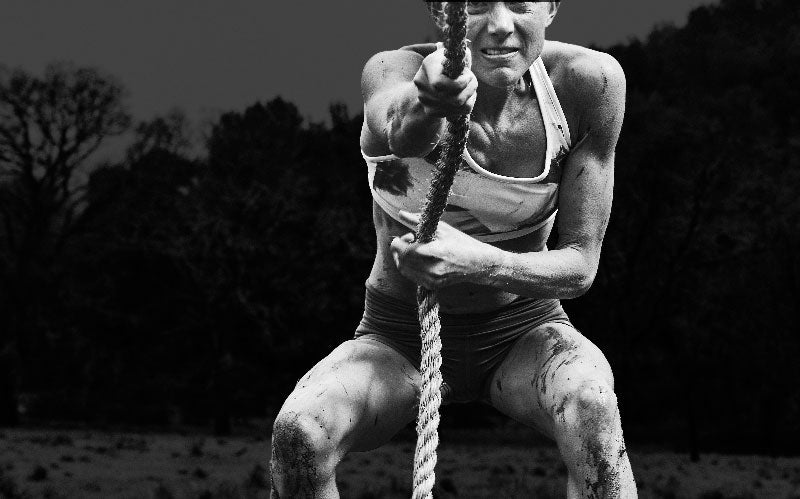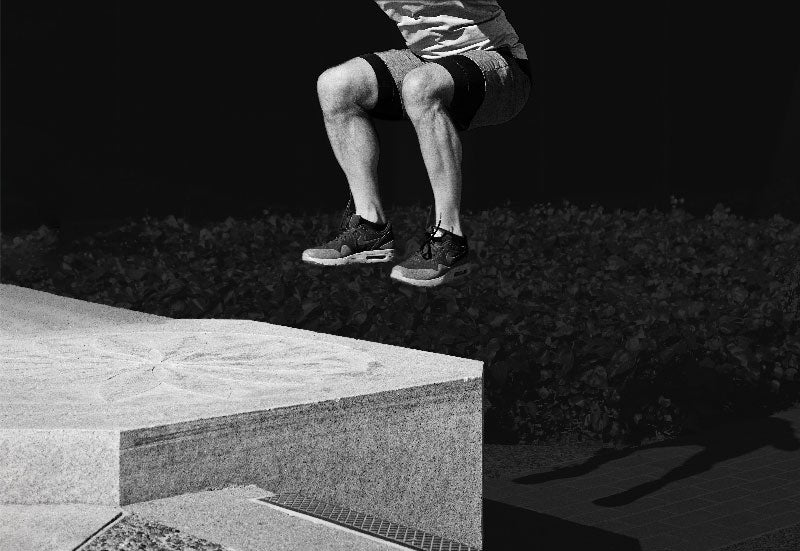Get Faster, Stronger and Fitter Through the Power of Data
Wearables and analytics are changing the way athletes perform, train and recover.
Malcolm Jones MS ’19 focuses on a computer screen as pictures of balls from different sports flash across it. The rules of the game: Tap only on the footballs. His fingers flick back and forth on the display. The balls soon disappear, and Jones learns his score — prompting a self-deprecating laugh.
“I have great hand-eye coordination, but I have no depth perception,” he says.
This is more than a game for fun. It’s part of testing that measures abilities like peripheral vision and object tracking. For athletes, it’s thought that improvements in these tasks translate to better decisions and reaction times in competition.
The program symbolizes something else, too: the emergence of sports science. It’s about how measurement is revolutionizing the way people train, heal and compete. At a time when wearable computers can track seemingly everything in the world of health — from blood pressure to sleep quality — these technologies have now hit athletics.
Analytics already has changed the business of sport. Look no further than stats used by pro baseball teams since the early 2000s to sign undervalued talent — made famous in the film Moneyball. Now teams are shifting attention to performance through sports science, outfitting athletes with sensors to help them train hard while staying healthy.
“The data game is about minimizing risk,” Leslie Saxon, a cardiologist and executive director of the USC Center for Body Computing, told attendees at an MIT Sloan Sports Analytics Conference. When the USC women’s soccer coach couldn’t figure out why a team with a legacy of national championships wasn’t winning, data from sensors alerted him that players were running six miles the day before a game, Saxon said. The aha moment spurred more rest before competition, leading to more wins and fewer injuries.
Today, scientists like Jones, a USC biokinesiology doctoral student, use data and technology to help athletes of all levels. To advance the movement, USC’s Division of Biokinesiology and Physical Therapy recently launched a Master of Science in biokinesiology program with a sports science emphasis.
“Everyone is after the holy grail of predicting performance, injury and health,” says Susan Sigward PhD ’04, associate professor of clinical physical therapy. “Advances in technology allow us to collect a lot of data and give us a greater capacity to store and share it. Sports science practitioners are now on the forefront of figuring out which data are relevant and what they mean for performance or recovery.”
Track Record
Watch enough training sessions with professional athletes and you might spot a small tell-tale bump between their shoulder blades. The tiny sensor — usually worn with a harness — is a GPS tracker, accelerometer and gyroscope that collects invaluable data to determine how hard their bodies are working during training and competition. How far did an athlete run? How much time did she spend sprinting? How many times did she come to a hard stop?
Sports science experts crunch these numbers to come up with a more complete athlete profile. Working with coaches, they use their data-driven insight to adjust training regimens with the goal of ensuring optimal health and readiness, Sigward says. The idea is to help avoid overtraining or undertraining. When athletes push too hard during practice, they may be more susceptible to fatigue and injury. When they don’t train hard enough, they might not be ready for the demands of the game, resulting in poor performance or injury.
Preventing overtraining can be challenging because there are many factors to consider, adds E. Todd Schroeder PhD ’00, associate professor of clinical physical therapy. Diet, sleep, hormones, performances and training intensity all play a part in an athlete’s health and well-being. Having more data on those variables helps both coaches and athletes recognize when they need to ease up or push a little harder.
“A simplistic example is using heart rate,” Schroeder says. “If you monitor the athlete’s heart rate response during practice each day, you can measure how much time he or she spends above 80% intensity. If he or she reaches their predetermined threshold, they would back off the training time or intensity.”
As more sports professionals see the value of data analysis, sports scientists are more in demand.
As more sports professionals see the value of data analysis, sports scientists are more in demand. In USC’s rigorous sports science program, students learn about data science but also cover biomechanics and physiology, Sigward says. That makes them attractive to sports teams and tech companies working on exercise apps and other consumer health products. “I will cautiously say USC is the first to teach this kind of applied sports science,” she says. “We’re teaching our biokinesiology students how to translate and use this tech.”
Students put their knowledge into action through hands-on work at places like the Meyer Institute of Sport, the Movement Performance Institute and the USC Epstein Family Center for Sports Medicine at Keck Medicine of USC. Many have landed internships with professional sports teams such as USA Volleyball, the Los Angeles Kings, the Oklahoma City Thunder and the Portland Timbers.
“Pro teams especially want to be out in front of this movement and using state-of-the-art stuff,” Sigward says. “They want to have their special sauce.”

Jump Start
Curious to find out how your reflex skills measure up on the field or court? Stop in at Nike’s Jordan brand retail and recreational space in downtown Los Angeles on any afternoon and you’ll find other local athletes — from elite pros to elementary school hopefuls — flocking to try the latest data-driven tech.
The three-story, 24,906-square-feet building is home to Jumpman LA’s Flight Lab. It features high-speed cameras, a motion-capture system, impact-sensing force plates, metabolic testing equipment and other gadgets dedicated to unlocking sports performance. Its rooftop basketball court is an ideal place to test out data trackers and tools like timing gates that clock reaction time, speed and agility.
The Flight Lab launched a partnership with USC that lets biokinesiology students and local athletes take a deeper dive into the science behind performance. “We have our labs at USC, but we were looking for something outside the university to get the public more involved,” Schroeder says. “It was serendipity.”
The collaboration emerged thanks to Jones, who worked part time as a Jordan brand ambassador for Nike, as well as the West Coast Jordan team, which welcomed the opportunity to work with community members who might not typically have access to their products and services. Partnering with the Flight Lab means USC researchers and students can work with the latest technology. That includes a prototype virtual reality treadmill that is one of the first of its kind in the world. It also means the USC biokinesiology experts and students test new equipment and give feedback on their usefulness to athletes, coaches and trainers.
“It’s big challenge, figuring out how to give the right answer without underselling or overselling something,” Sigward says. “Studies are expensive, and we’ve been lucky to start leveraging our relationships to get this equipment and find those answers.”

Sports Science Tools of the Trade
Exercise too hard and you risk injury and overtraining. Go too easy and you won’t be at your best on game day. Data-driven tools and new technology ensure that athletes find that sweet spot of building healthy muscle for peak performance while reducing their chances of getting hurt. Here are some of sports science’s gadgets and data-analyzing tech that coaches, trainers and athletes are using to stay at the top of their game.
Insider Information: Evaluating heart, lungs and body composition
Runners, cyclists and other endurance athletes need strong cardiovascular fitness. One measure of fitness: how much oxygen an athlete can breathe in and send to muscles for exercise. That number is called VO2 max. Want to make it easier to run or ski faster? Boost your VO2 max. Sports scientists now can monitor VO2 max with a device that athletes wear in a small backpack.
“We used to have a big cart sitting next to a treadmill, and you’d be hooked up to all these tubes,” Schroeder says. “Now it’s a 1.5-pound box that fits in a little backpack. You still wear a mask, but I had a Nike executive wearing it and shooting baskets for half an hour. He said, ‘It didn’t affect my shot at all!’”
Want to hit that lung-punishing anaerobic zone on your morning run? A heart rate monitor can help you stay at the right intensity level during your workout. The device measures heartbeats per minute, helping athletes train hard enough to boost their VO2 max or easy enough to condition muscle gradually.
Want to hit that lung-punishing anaerobic zone on your morning run? A heart rate monitor can help you stay at the right intensity level during your workout.
Another tool to find out what you’re made of — literally — is a body composition analyzer. Using bioelectrical impedance, the device sends a painless electrical current through your body to calculate water content, muscle and fat percentage, proteins and other variables. The more precise — and pricey — models can break down those numbers by body part: arms, legs and torso.
Powering Up: Gauging strength and endurance
Hard landings can strain joints, especially if one leg bears more impact. Sports scientists use force plates to calculate how fast and powerfully an athlete jumps and how forcibly they land. Numbers can also show if athletes favor one side during injury recovery.
“More than a 10% difference between legs is something we might consider as favoring one side,” Jones says. “A larger asymmetry is related to increased risk of injury.”
When athletes do pull a muscle or tweak a tendon, you might think their injury would benefit from rest. But decreasing blood flow to a limb while exercising the muscle at the same time as part of physical therapy releases hormones that aid recovery. Athletes also can use a band or cuff to restrict blood flow during strength training. Recent research has shown that this technique enables athletes to build more muscle with lighter weights.
“It makes the exercise very challenging because the muscle has minimal oxygen,” Schroeder says. “It’s a way to train at lower loads and still get the same results as training with heavy loads. And it’s great for rehab if someone has a knee ligament injury.”
Jones is leading a six-week study with 40 USC students who are completing a training program with blood flow restricted to one of their legs. At the end of the program, the USC team will examine differences in hamstring strength, fatigue, power and muscle mass.
If you find running on a treadmill a slog, USC researchers have an idea that might help. They’re exploring whether virtual reality gaming components — say, jogging faster to fight off an army of encroaching sea creatures — could encourage people to stay on a treadmill for longer and burn more calories.
The latest VR treadmill prototype can also measure pressure on the treadmill deck to help sports scientists identify a runner’s center of mass and body position.
“It would allow us to determine if someone is putting more weight on one side of the body to compensate for an injury or soreness,” Schroeder says. “We can then work with them to develop symmetry, which will help prevent future imbalances and injury.”
The researchers are applying the same kind of data gathering to high-tech indoor stationary bikes that can size up a person’s leg power, aerobic endurance and muscle endurance.
Think Fast: Clocking speed and reaction time
Successfully translating split-second decisions into physical action could mean the difference between winning or losing a game. Gaining insight into an athlete’s reaction time, hand-eye coordination and many other abilities can be valuable to improve their overall performance.
Along with traditional speed tests, USC researchers use timing gates to evaluate agility and reaction time. They also have a sensory station to assess visual and sensorimotor skills — like quickly shifting focus between objects at different distances. A third tool, strobe glasses, help athletes train the connections between their brain, eyes and body. The glasses flash between clear and opaque, forcing the athlete to deal with less visual information while performing physical feats.
Using high-speed video cameras, sports scientists can closely scrutinize body mechanics in second-by-second components from several angles.
To help athletes move faster and more efficiently, trainers need to first need to understand how they move. Using high-speed video cameras, sports science experts can closely scrutinize body mechanics in second-by-second components from several angles. This spotlights problematic movements that might lead to injury or reveal opportunities to improve power or precision.
Interested in learning more? Visit the USC Division of Biokinesiology and Physical Therapy online for information on the master’s in kinesiology with a sports science emphasis.



